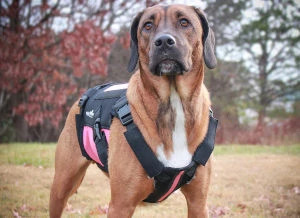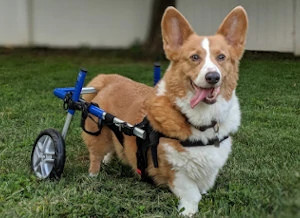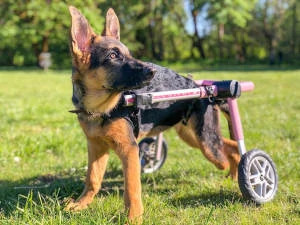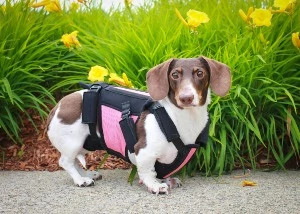How To Prevent Ivdd In Dachshunds
IVDD in dogs (intervertebral disc illness) has a range of symptoms, from relatively mild to very serious. On 1 end of the spectrum is mild pain, paralysis on the other, and well-nigh dogs with the diagnosis falling somewhere in-betwixt.
Causes of IVDD in Dogs
IVDD is a illness that affects the spinal cord over time, only it might not be apparent until there is a trigger. Unfortunately, a canis familiaris who appears to exist completely salubrious one day may take a fall or jump in such a way that a disc becomes ruptured. IVDD is a degenerative (gradual) procedure, but a jump or autumn can damage a disc that has already been weakened by IVDD and bring on an acute phase of the affliction.

The disease is acquired when the cushioning discs (which function as shock absorbers) between the vertebrae of the spinal column begin to harden. Eventually, they may harden to the point that they can no longer adequately cushion the spinal vertebrae.
Consequently, a forceful jump or bad landing can cause a disc (or discs) to outburst and press into the nerves running through the spinal cord. This can be painful and cause nerve damage and/or eventual paralysis.
Alternatively, the hardening of the discs can eventually cause them to burl and compress the spinal cord. This can harm the nerve impulses such that float and bowel control can be impaired, in addition to potentially causing paralysis.
Checklist of IVDD Symptoms
How can I tell if my dog has a slipped disk? Recognizing the signs of IVDD is crucial to getting your dog care quickly. IVDD signs tin can sally gradually or be intermittent or sudden. While whatever dog breed can experience IVDD, some breeds are more decumbent to the disease. Early intervention is crucial in order to minimize the possibility of permanent nerve damage. Here are some common symptoms of Intervertebral Disk Disease in dogs:
- Stiffness of neck, limbs, or back
- Dragging rear leg(s)
- Knuckling under
- Obvious weakness or pain
- Lowered caput when continuing or a rounded back can indicate spinal hurting
- Increased sensitivity to movement or affect
- Impaired gait
- Paralysis
- Incontinence
- Back/muscle spasms
A domestic dog'south IVDD symptoms can vary in severity. Non every dog with a slipped disc volition go completely paralyzed. A dog may take trouble walking on i or more of its legs depending on the severity of the herniated disc and which part of the spinal cord is afflicted.
Which Breeds Are About Likely to Get IVDD?
Certain breeds are more likely to get IVDD due to a disorder of their cartilage formation chosen chondrodystrophic. The disease generally occurs in these breeds at historic period 3 to 6 years old. Typical breeds of this type include:

- Bassett Hounds
- Beagles
- Bulldogs
- Corgis
- Cocker Spaniels
- Dachshunds (most mutual)
- Pekingese
- Poodles
- Shih Tzus
Nonchondrodystrophic breeds that are often affected past IVDD include:
- German Shepherds
- Labrador Retrievers
- Doberman Pinschers
Overweight dogs in whatever brood are more likely to get IVDD.
Diagnosis and Treatment of IVDD

Diagnosing your dog's IVDD begins with a veterinary examination. The examination will generally include a neurological exam, X-rays, and/or special imaging (myelogram, CT scan, MRI) to locate the source of spinal injury.
If the diagnosis reveals mild to moderate injury, IVVD treatment may include the administration of steroids and anti-inflammatory medications to reduce swelling and pain, with bars rest required for four to six weeks or so.
In more severe cases, surgery may be advised to open upwards the space around the spinal cord. IVDD surgery has a better chance of being successful if the dog has non lost the power to walk and if surgery is washed very presently after diagnosis (within 24 hours). If a dog has already lost the ability to walk before surgery, the prognosis is non optimal.
Post-surgical concrete rehabilitation is often recommended for musculus strengthening. If surgery is not successful, a dog wheelchair is often recommended, which can give the dog a good for you, active life despite the illness.
Tin can a Dog Recover from IVDD?
It is possible for a pet to recover from IVDD. Whether you lot decide on surgery to correct your dog's disc rupture or choose crate rest and physiotherapy, IVDD recovery is possible.
There are cases where IVDD dogs have regained complete part of their back legs, simply every IVDD case is dissimilar. Information technology'due south important to remember that at that place are many stages of IVDD, and every dog recovers in their own time and responds to IVDD handling differently. Many dogs make a full recovery, peculiarly when given the time to heal and proper therapy to rebuild strength.
IVDD Back Caryatid

Helping save a dog's back pain can provide pain relief and preclude farther injuries. An orthopedic back brace tin can help support your dog's back and spine as they prepare for surgery or pets looking for a not-surgical option. For dogs with IVDD, the all-time back brace will characteristic retention foam layers that arrange to the natural contours of their dorsum for optimal support. IVDD back braces support the spine and stabilize the back to promote movement and eliminate back hurting.
Co-ordinate to Dr. Terry Fossum DVM, "A dorsum brace will non cure IVDD, just information technology may help stabilize the spine and reduce further herniation. The back brace should be rigid enough to restrict motion of the spine but not so rigid that information technology is uncomfortable for your pet to article of clothing or so tight that information technology restricts breathing. Limitation of your pet's action is still important!"
Crate rest is a crucial component of any IVDD dog's recovery process, and although a back caryatid volition not replace crate rest, it tin can play an essential function in a dog's IVDD recovery. Along with rest, mobility assistance and back support are crucial IVDD solutions to help your dog recover.
IVDD Prevention
There are some easy and practical things a pet owner can exercise to minimize the risk of IVDD for their pets:
- Go on your dog's weight down to reduce neck and dorsum stress, especially for breeds predisposed to the disease.
- Use a harness when going on walks to reduce neck stress that tin can occur if using a neck leash. The best harness for IVDD is 1 that distributes the weight across their breast and abroad from their neck.
- Minimize jumping on/off furniture
- Loftier-risk dog breeds with long backs, such equally dachshunds, need to be supported when picked up. Dachshunds should simply be picked up when their entire body is supported from underneath by your arm. Never pick upward a dachshund from behind their front legs with their trunk dangling, this is bad for their dorsum.
- Finally, consider a dorsum brace to minimize adventure.
IVDD recovery is a long process, be patient and follow your Veterinarian's guidance to help your dog heal.

Related Articles:
Did we respond all your questions on "IVDD"?
Source: https://www.handicappedpets.com/blog/ivdd-in-dogs/

0 Response to "How To Prevent Ivdd In Dachshunds"
Post a Comment